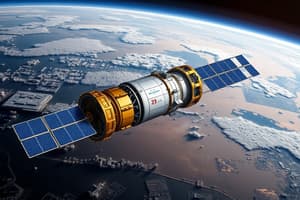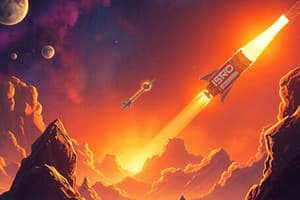Podcast
Questions and Answers
What was the primary reason for India to develop its own navigation system, NavIC?
What was the primary reason for India to develop its own navigation system, NavIC?
- To reduce reliance on foreign navigation systems and ensure sovereign control, particularly after experiences during the Kargil War. (correct)
- To provide a backup system in case of failure of the Russian GLONASS system.
- To compete with the European Galileo system in the commercial sector.
- To offer more accurate navigation data than the US GPS system for civilian applications.
How did US restrictions on technology transfer from Russia affect India's space program?
How did US restrictions on technology transfer from Russia affect India's space program?
- They led to the cancellation of the GSLV program due to a lack of crucial components.
- They had no significant impact because India already had the necessary technology.
- They forced India to collaborate with European space agencies for technology development.
- They caused delays in the GSLV's development but ultimately spurred the indigenous development of cryogenic engine technology. (correct)
Which of the following best describes the significance of the Mangalyaan mission?
Which of the following best describes the significance of the Mangalyaan mission?
- It was the first mission to discover water ice on the Martian surface.
- It established India as the first country to land a rover on Mars.
- It marked India as the first nation to successfully orbit Mars on its first attempt, achieving this cost-effectively. (correct)
- It was a joint mission with the US, aimed at mapping the Martian atmosphere in detail.
Besides space exploration, how has ISRO's work impacted other sectors in India?
Besides space exploration, how has ISRO's work impacted other sectors in India?
What do ISRO's future plans include?
What do ISRO's future plans include?
Which of the following best describes the significance of the Thumba Equatorial Rocket Launching Station (TERLS) in ISRO's early days?
Which of the following best describes the significance of the Thumba Equatorial Rocket Launching Station (TERLS) in ISRO's early days?
What was the main driving force behind Dr. Vikram Sarabhai's vision for the Indian space program?
What was the main driving force behind Dr. Vikram Sarabhai's vision for the Indian space program?
How did the establishment of the Department of Space in 1972 impact ISRO's operations?
How did the establishment of the Department of Space in 1972 impact ISRO's operations?
What was the primary objective of the SLV (Satellite Launch Vehicle) project?
What was the primary objective of the SLV (Satellite Launch Vehicle) project?
What critical capability did the PSLV (Polar Satellite Launch Vehicle) provide to ISRO's mission profile?
What critical capability did the PSLV (Polar Satellite Launch Vehicle) provide to ISRO's mission profile?
What was a major technological hurdle faced by ISRO in the development of the GSLV (Geosynchronous Satellite Launch Vehicle)?
What was a major technological hurdle faced by ISRO in the development of the GSLV (Geosynchronous Satellite Launch Vehicle)?
How did the launch of Aryabhata in 1975 contribute to the Indian space program?
How did the launch of Aryabhata in 1975 contribute to the Indian space program?
What distinguishes the PSLV from the GSLV in terms of their primary mission capabilities?
What distinguishes the PSLV from the GSLV in terms of their primary mission capabilities?
Flashcards
GSLV Development
GSLV Development
The development of the Geosynchronous Satellite Launch Vehicle by ISRO, delayed by US technology transfer restrictions.
NavIC
NavIC
Navigation with Indian Constellation, India's indigenous satellite navigation system developed by ISRO.
Chandrayaan-1
Chandrayaan-1
The first Indian lunar mission that discovered water on the moon in 2008.
Mangalyaan
Mangalyaan
Signup and view all the flashcards
ISRO's Impact
ISRO's Impact
Signup and view all the flashcards
ISRO
ISRO
Signup and view all the flashcards
Dr. Vikram Sarabhai
Dr. Vikram Sarabhai
Signup and view all the flashcards
Aryabhata
Aryabhata
Signup and view all the flashcards
SLV
SLV
Signup and view all the flashcards
PSLV
PSLV
Signup and view all the flashcards
GSLV
GSLV
Signup and view all the flashcards
Sounding Rockets
Sounding Rockets
Signup and view all the flashcards
Department of Space
Department of Space
Signup and view all the flashcards
Study Notes
Early Years of ISRO: A Humble Beginning
- ISRO, the Indian Space Research Organisation, began as INSA (Indian National Space Research Committee) in 1962.
- India faced challenges like poverty, illiteracy, and post-war recovery during this time.
- Dr. Vikram Sarabhai, the father of the Indian space program, envisioned space technology for national development.
- Dr. Homi J. Bhabha, architect of India's nuclear program, supported Sarabhai's vision.
- The first sounding rocket launched on November 21, 1963, from a makeshift pad near a Kerala church.
- Sounding rockets tested space technologies and equipment.
Establishment of ISRO and Early Successes
- INSA became ISRO on August 15, 1969, under the Department of Atomic Energy.
- A separate Department of Space established in 1972, giving ISRO its own governing body.
- Aryabhata, India's first satellite, launched in 1975, using a Soviet rocket.
The SLV Project: A Path to Self-Reliance
- ISRO aimed for self-reliance in satellite launches, developing the SLV (Satellite Launch Vehicle).
- The first SLV launch (1979) failed due to a malfunction.
- ISRO persevered, successfully launching Rohini in 1980, establishing India's launch capabilities.
The Rise of PSLV: A Game-Changer
- ISRO developed the PSLV (Polar Satellite Launch Vehicle) for heavier payloads and higher orbits (polar and geosynchronous transfer).
- PSLV's first launch (1993) failed, but later launches achieved high success rates.
- PSLV launched many satellites, including Chandrayaan-1 and Mangalyaan.
- PSLV's reliability is noteworthy, launching multiple satellites successfully.
Mastering Cryogenics: The GSLV and the Quest for Independence
- ISRO faced the challenge of developing its own cryogenic engine technology for the GSLV (Geosynchronous Satellite Launch Vehicle) for heavier satellites in geosynchronous orbit.
- US restrictions on technology transfer from Russia slowed GSLV development.
- ISRO successfully developed indigenous cryogenic engine technology.
- The indigenous GSLV engine significantly enhanced India's launch capabilities.
The Birth of NavIC: A Strategic Necessity
- India's reliance on US GPS during the Kargil War highlighted the need for an indigenous navigation system.
- ISRO developed NavIC (Navigation with Indian Constellation), granting India space-based navigation sovereignty.
A Legacy of Success: Chandrayaan, Mangalyaan, and Beyond
- Chandrayaan-1 (2008) discovered water on the moon.
- Mangalyaan (2013) was India's first successful Mars mission, efficient and cost-effective.
- Chandrayaan-2 (2019) deployed a lander to the moon's surface.
- Chandrayaan-3 achieved a successful lunar landing near the Moon's south pole.
ISRO's Impact and the Future
- ISRO's spin-off technologies impact healthcare, agriculture, and disaster management.
- ISRO inspires a generation of scientists and engineers.
- Future plans involve a space station and international collaborations.
- ISRO's resilience and innovation demonstrate India's space exploration and technology achievements, contributing globally.
Studying That Suits You
Use AI to generate personalized quizzes and flashcards to suit your learning preferences.



